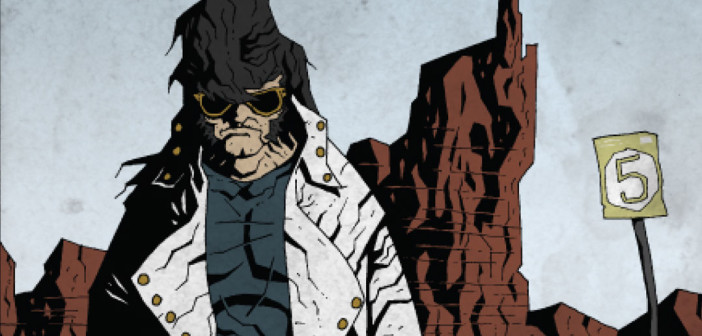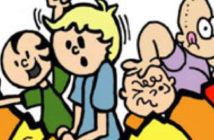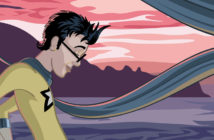Why is it that as I read Thomas Hall and Daniel Bradford’s KING!, I couldn’t help but think of Mickey Rourke? The comic’s main character, King, has the build and posture of Rourke from Darren Aronofsky’s The Wrestler, but every time King spoke a line of dialogue, I heard the gravelly and liquor-soaked voice of Rourke’s Marv from Robert Rodriguez and Frank Miller’s Sin City. But none of this detracts from the book; if anything, it adds to the level of its overall character.
I call the lead character of KING! King because of his certain resemblance to, well, the King of Rock and Roll. (Forgive me for the repetitive use of the word “king”; it’s unavoidable.) It’s not revealed if this guy is the real deal or if he’s a weathered, hackneyed impersonator. But knowing the sense of humor of writer Hall and artist Bradford, I’m willing to assume the legend here is authentic.
Regardless, it doesn’t look like King is much of a performer anymore. He lives alone in a cabin out in the middle of a nameless desert, and we first meet him when a delivery boy brings to him a package. It’s two in the afternoon, and the unwanted visitor interrupts King’s beauty rest, provoking him to shoot out the kid’s Vespa just enough to teach him a lesson.
In expected Hall/Bradford fashion, the object in the package is an oddity: a beating, talking, and robotic heart that is mobile through the use of miniature helicopter blades. Where the heart came from, we don’t know, but it certainly has a purpose: to hire King as a mercenary, as he seems to have a reputation for killing things—monstrous things. His mission is to stake out a local fast-food restaurant and wait for the arrival of dimensional zombies led by their heathen god.
King does so, and he’s confronted by his enemies when a local rube mistakes the Spear of Longinus for an ancient bread knife. The spear is an old standby relic in speculative fiction anymore, but it’s not taken so seriously here that it impedes the story’s purpose, which is focused on monsters and jokes. Of that, the creators deliver. There’s an all-out brawl in the burger joint, but Bradford controls the panels well; we never miss a bit of the action because of sloppy and confusing art. He possesses true finesse.
Hall and Bradford are best known for their successful independent title, Robot 13, which I’ve been reading, reviewing, and enjoying since the beginning. I appreciate Hall as a writer because he’s not manic with his words; he doesn’t weight down his pages with unruly caption boxes bloated with worthless narration. He strikes me just as much as a director of these comics as he is the writer.
Bradford’s art is spot-on, and I’d expect no less from him. He’s often compared to Mike Mignola, and while it’s sometimes used as a slam against him, I see no shame in it. But there are hints of Kevin O’Neill in his work too, and the artist has told me in the past that he’s inspired by the illustrations of Stephen Gammell from the Scary Stories to Tell in the Dark series of children’s books. I see it all, converging into some of the best art coming out of the independent scene.
I’m surprised to be saying this, but part of me likes KING! more than Robot 13, and I love Robot 13. They have a lot in common—armies of monsters, an oddball hero, weirdo supporting characters—but Robot 13 is somewhat solemn where KING! is simply humorous. I appreciate both books very much, but in this instance, I’m siding with the funny one.
This comic book review originally appeared on Broken Frontier.




